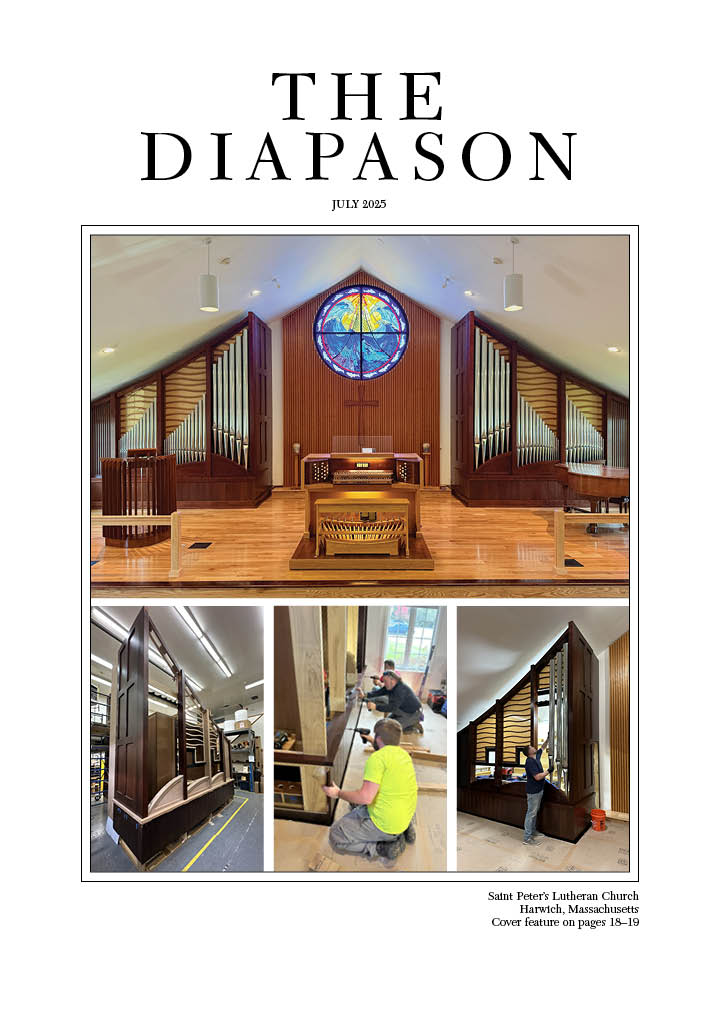Herbert L. Huestis is a contributing editor of THE DIAPASON.

Making a crescendo with the least number of stops
Perhaps there is no more obvious a signature item on factory-built organs than the ubiquitous crescendo pedal. In most cases, it stands for nothing more than a fuzzy blob of sound, rising from the celeste and culminating in a tremulous mass of stops that does little more than tax the wind of the organ and test the thoroughness of the last tuning. Most artisan organ builders ignore the crescendo pedal, even when installing programmable sequencers and the like. It seems to remain an option that factories dare not leave out, for fear it might be the item that tips a contract toward another builder. The crescendo is almost never seriously discussed in any negotiations and once set is rarely revisited.
The worst episode of "crescendo abuse" I have encountered was during a performance of Handel's Messiah, where the accompanist set a few stops, including super couplers, then proceded to pump the crescendo for variation. The organ alternatively shrieked and wheezed, depending on the stops that were engaged with the super couplers.
During my career as an organ technician very few organists have ever asked about the crescendo pedal, much less entertained notions about how to use it effectively. I was taken aback when a brilliant organist asked me what I could do with not only one, but two crescendo pedals!
He had some ideas he wanted to explore, but first, there was a matter of technology. Ordinary crescendo rollers are not programmable. They are hard-wired--set up for the occasional adjustment, but not much more.
I asked this young organist if he was serious about pursuing such a thing. He assured me he was, and I contacted Scott Peterson of Peterson Electro-Musical Products, and Art Young of the Syndyne Corporation to find out what technical means might be available to program two crescendo pedals. Both firms had the capability to provide programmable functions, but neither could come up with a system that was cost effective. However, the idea was born and the project got underway.
Cost was an inevitable factor and a computerized system was ruled out almost immediately. The only option that remained was some sort of "switchboard" that would enable hard-wired roller contacts to be easily set in the order the organist envisioned. For a three-manual 60-stop organ, two lists were generated, using only 30 to 35 stops for the entire crescendo. The desired effect was suitable crescendi for oratorio accompaniment, so each pedal started with an ensemble, rather than a single stop. In the crescendo that proceeded from each small ensemble, there were various breaks, rather than a steady rise in volume. The musical plan was to build a series of stop changes one might find on a sequencer, rather than merely advancing from a whisper to a roar.
Since this is something of a technical note, I'd like to concentrate on two aspects of the project. As one can see from the photo, a board with about 80 contacts must be constructed to accept the input from each contact roller along with an array of 24 indicator lamps for each pedal. The inputs from these 2 contact rollers feed through mini-switchboards to a central feed to the console stop union. This method provides an inexpensive system that permits easy (and probably ongoing) adjustment of various stops, strategic location of "breaks" and wiring of small groups of stops in stages. With that technology in place, the ingenuity of the organist could prevail. By reducing the number of steps from over 60 to about 30, the musical effect he had envisioned was obtained.
This was far more useful than a factory pre-set system. As one might suspect, the Tutti controls on this same organ are preset in a similar manner. Rather than drawing on all stops with the "full organ" button, the loudest ensemble is provided with the least number of stops required; again, about thirty. The "less is more" theory really works!


